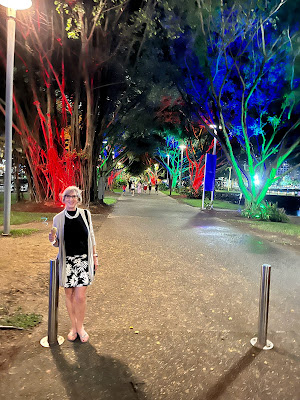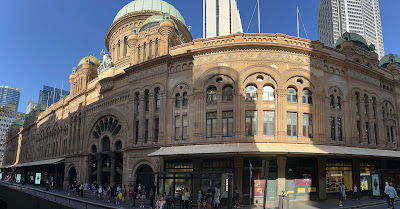Our stay in Sydney served both our needs to get over our jet lag and do some planning for the first stop on our east coast Australian adventure, the Daintree Rainforest, and Cairns, in north Queensland.
We had a great three-hour flight on Jetstar from Sydney to Cairns. More leg room and far better food than our Air Canada flight from home. We had transportation waiting for us at the Cairns airport (for some reason pronounced Cans by all Australians) to whisk us another half hour north to Palm Cove's Paradise Resort hotel. Palm Cove is a small seaside town with a string of shops, bars, and restaurants concentrated over a kilometer of the beach. We enjoyed the feel of the place and if not for the daily deluge of rain we could have stayed a little longer. Palm Cove has a much more laidback vibe compared to the upscale Port Douglas another half hour north up the road.
Looking back, we learned a few things about the Wet Tropics of Queensland.
The first is just how much it rains. The lush green, jungle-type foliage is a result of near-constant daily rain. October and November are the only months when it rains "a little less" according to the locals. Of course, what makes it bearable is that the sun also shines almost daily and the temperatures usually attain a high of around 28 to 30 degrees Celsius.
 |
Daintree Rainforest meets the Great Barrier Reef |
The second is that while we were fully aware of the presence of sharks in Queensland waters, we didn't realize that sharks would be the least of our problems when entering the sea. The Queensland coast is home to many types of jellyfish (or stingers as the locals call them). The areas we visited were home to one of the most deadly Irukandji jellyfish. They are so small one usually cannot see the tiny (small fist-size) bell-shaped little guys. The Irukandji's venom is among the most deadly in the world, containing toxins that attack the heart, nervous system, and skin cells. Our beach had a swimming net but we were informed that the Irukandji were so small they could pass through the netting. Needless to say, we didn't go swimming.
 |
Lifeguard patrolling the net enclosure for jellyfish "stingers" |
Our third "ah ha!" moment was the increased awareness of the menace of crocodiles. Queensland is home to about 100,000 crocodiles counting both saltwater and freshwater species. Essentially, they have all the swimming options covered. Crocs may be the descendants of the dinosaurs but they have adapted well. Saltwater crocs can now live in fresh water. Their reptilian brains have adapted to make them apex hunters in this region. They will lay in wait for days to track the patterns of their prey on land. On average, there are around 50 croc attacks in Australia each year resulting in two deaths. The average adult "saltie" weighs in at 1000 kg and measures 5 meters from nose to tail. They're a menace in the water propelled by their powerful tails but on land, they can run up to 13 km/hr (the same speed as the average man). There is no accounting for the number of dogs and other pets that disappear after walking too close to the water's edge. We were surprised to see so many tourist warning signs not to walk in certain areas because of recent croc sightings.
 |
A "saltie" was spotted by the shoreline at Cape TribulationStingers and Salties - just two of the menaces in OzCroc safety "stay 5m from the shoreline", hmmm! |
Our first day in Palm Cove was to be about getting out on the water to see the Great Barrier Reef. Unfortunately, the heavy rains made those plans moot. We switched to riding bikes, swimming, and playing a little tennis near the resort but the weather forecast of periods of rain put a stop to that. We quickly pivoted to renting a car to explore the Mossman Gorge in the Daintree forest and drive north to Cape Tribulation to explore where the jungle meets the ocean near the beginnings of the Great Barrier Reef. This plan worked.
We got lucky with the weather and contrary to the forecast, we enjoyed most of the day under blue skies. Unfortunately, our visit to the Mossman Gorge in the Daintree Rainforest National Park was hindered by a tourist death in the park's waters the day before. We switched again and enjoyed lunch in a nearby Daintree, a tiny rainforest village.
 |
George meets George, a stuffed croc from the Daintree River nearby |
We drove north through the park to Cape Tribulation. Deborah's pictures are far better than words in telling the story of the beaches, mangrove swamps, and boardwalk flora and fauna.
Day two was a trip on the Kuranda Railroad. We boarded 1930-era passenger rail cars pulled by 1960-era diesel engines to climb to the top of the mountain escarpment to visit the former mining, and now artsy/tourist town of Kuranda. It rained heavily but the views were still fantastic and the various waterfalls were in full fury due to the high waters. After a few hours of walking the town and having lunch, we were to travel down in gondolas to view the rainforest from the top of the canopy but sadly the heavy rain put a stop to the aerial tram and we bussed down. Some disappointment but we still had a great day.
 |
Karandu Scenic Railway |
 |
Aboriginal art - the elusive cassowary as big as 6'6" and 129 lbs |
 |
Aboriginal art - didgeridoos |
On day three we transferred to the Pacific Hotel in Cairns to preposition for our nine-hour train trip to Airlie Beach the following day. Unfortunately again, the tremendous rains had washed out the tracks down south with little indication of how many days it would take to repair. We spent the bulk of the day trying to find a way south either by bus or plane. Neither of those was possible so we decided to rent a car and make the 650km journey over land and roll the dice hoping that the flood waters would have receded enough to keep the road open. After securing a car, we relaxed.
While we were frustrated that the weather prevented us from going our to the Reef, we did the next best thing and visited the Cairns Aquarium. The aquarium displays all the flora and fauna we would have seen on the reef. It even has special living coral displays. It was well worth the price of admission.
 |
Great Barrier Reef Puffer fish |
After the aquarium visit, we did some shopping, had a walk around the town, and enjoyed a fine meal on the waterfront and a beautiful stroll along the lively Esplanade.
Cairns is a very clean, orderly, picturesque city of around 150,000. It serves as a cruise ship terminal and a jumping-off point to all things Great Barrier Reef orientated.
We were up early the next morning and embarked on an eight-hour drive to our next destination, Airlie Beach, a jumping-off point to all things Whitsundays oriented.



































